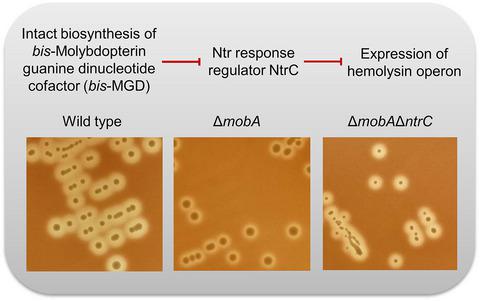当前位置:
X-MOL 学术
›
Mol. Microbiol.
›
论文详情
Our official English website, www.x-mol.net, welcomes your
feedback! (Note: you will need to create a separate account there.)
Bis-molybdopterin guanine dinucleotide modulates hemolysin expression under anaerobiosis and contributes to fitness in vivo in uropathogenic Escherichia coli
Molecular Microbiology ( IF 2.6 ) Pub Date : 2021-09-08 , DOI: 10.1111/mmi.14809 Xinyang Zhang 1 , Dongyan Huang 2, 3 , Zihui Zhao 1 , Xuwang Cai 3 , Wentong Cai 1 , Ganwu Li 1, 3
Molecular Microbiology ( IF 2.6 ) Pub Date : 2021-09-08 , DOI: 10.1111/mmi.14809 Xinyang Zhang 1 , Dongyan Huang 2, 3 , Zihui Zhao 1 , Xuwang Cai 3 , Wentong Cai 1 , Ganwu Li 1, 3
Affiliation

|
Uropathogenic Escherichia coli (UPEC) is the primary causative agent of urinary tract infections (UTIs). Successful urinary tract colonization requires appropriate expression of virulence factors in response to host environmental cues, such as limited oxygen and iron availability. Hemolysin is a pore-forming toxin, and its expression correlates with the severity of UPEC infection. Previously, we showed that hemolysin expression is enhanced under anaerobic conditions; however, the genetic basis and regulatory mechanisms involved remain undefined. Here, a transposon-based forward screen identified bis-molybdopterin guanine dinucleotide cofactor (bis-MGD) biosynthesis as an important factor for a full transcription of hemolysin under anaerobiosis but not under aerobiosis. bis-MGD positively influences hemolysin transcription via c3566-c3568, an operon immediately upstream of and cotranscribed with hlyCABD. Furthermore, suppressor mutation analysis identified the nitrogen regulator NtrC as a direct repressor of c3566-c3568-hlyCABD expression, and intact bis-MGD biosynthesis downregulated ntrC expression, thus at least partially explaining the positive role of bis-MGD in modulating hemolysin expression. Finally, bis-MGD is involved in hemolysin-mediated uroepithelial cell death and contributes to the competitive fitness of UPEC in a murine model of UTI. Collectively, our data establish that bis-MGD biosynthesis plays a crucial role in UPEC fitness in vivo, thus providing a potential target for combatting UTIs.
中文翻译:

双钼蝶呤鸟嘌呤二核苷酸在厌氧条件下调节溶血素的表达并有助于尿路致病性大肠杆菌的体内适应性
尿路致病性大肠杆菌( UPEC ) 是尿路感染 (UTI) 的主要病原体。成功的尿路定植需要适当表达毒力因子以响应宿主环境线索,例如有限的氧气和铁可用性。溶血素是一种成孔毒素,其表达与 UPEC 感染的严重程度相关。以前,我们发现在厌氧条件下溶血素表达增强;然而,所涉及的遗传基础和调节机制仍未确定。在这里,基于转座子的正向筛选鉴定了双钼蝶呤鸟嘌呤二核苷酸辅因子(双-MGD) 生物合成作为溶血素在厌氧条件下而不是在需氧条件下完全转录的重要因素。bis -MGD 通过c3566- c3568 积极影响溶血素转录, c3566-c3568是一个直接位于 hlyCABD 上游并与hlyCABD 共同转录的操纵子。此外,抑制突变分析确定氮调节剂 NtrC 是c3566-c3568 - hlyCABD表达的直接抑制因子,并且完整的bis -MGD 生物合成下调了 ntrC表达,因此至少部分解释了bis -MGD 在调节溶血素表达中的积极作用。最后,二-MGD 参与溶血素介导的尿路上皮细胞死亡,并有助于 UPEC 在 UTI 小鼠模型中的竞争适应性。总的来说,我们的数据确定bis -MGD 生物合成在体内 UPEC 适应性中起着至关重要的作用,从而为对抗 UTI 提供了潜在的目标。
更新日期:2021-10-25
中文翻译:

双钼蝶呤鸟嘌呤二核苷酸在厌氧条件下调节溶血素的表达并有助于尿路致病性大肠杆菌的体内适应性
尿路致病性大肠杆菌( UPEC ) 是尿路感染 (UTI) 的主要病原体。成功的尿路定植需要适当表达毒力因子以响应宿主环境线索,例如有限的氧气和铁可用性。溶血素是一种成孔毒素,其表达与 UPEC 感染的严重程度相关。以前,我们发现在厌氧条件下溶血素表达增强;然而,所涉及的遗传基础和调节机制仍未确定。在这里,基于转座子的正向筛选鉴定了双钼蝶呤鸟嘌呤二核苷酸辅因子(双-MGD) 生物合成作为溶血素在厌氧条件下而不是在需氧条件下完全转录的重要因素。bis -MGD 通过c3566- c3568 积极影响溶血素转录, c3566-c3568是一个直接位于 hlyCABD 上游并与hlyCABD 共同转录的操纵子。此外,抑制突变分析确定氮调节剂 NtrC 是c3566-c3568 - hlyCABD表达的直接抑制因子,并且完整的bis -MGD 生物合成下调了 ntrC表达,因此至少部分解释了bis -MGD 在调节溶血素表达中的积极作用。最后,二-MGD 参与溶血素介导的尿路上皮细胞死亡,并有助于 UPEC 在 UTI 小鼠模型中的竞争适应性。总的来说,我们的数据确定bis -MGD 生物合成在体内 UPEC 适应性中起着至关重要的作用,从而为对抗 UTI 提供了潜在的目标。











































 京公网安备 11010802027423号
京公网安备 11010802027423号